One area where significant changes can be made for businesses is within your company’s logistics – and in today’s post, we’ll show you how. Offering a number of ideas on how you can take the right steps towards creating a logistic strategy that not only reduces your environmental impacts, but also drives growth and reduces overheads in the process, you’ll be better equipped to create a sustainable and greener logistic model that’s built for the future.
Lower emissions
With figures from the European Commission stating that heavy-duty vehicles make up around 25% of road transportation’s CO2 emissions in the EU and 6% of total emissions, it’s fair to say that shipping goods from A to B comes with obvious environmental implications. So, reducing your logistic’s carbon emissions should be a leading priority for achieving sustainability.
Naturally, it’s not realistic to completely eradicate all the impacts as your business wouldn’t be able function or meet market supply and demand, but it is possible to take appropriate action to lower the emissions generated through transporting goods.

An obvious place to start would be to review transportation routes to identify if there are any reductions in mileage that can be made – even just a few miles less on a delivery route could work towards lowering your company’s carbon footprint and avoid you facing penalties or fines for breaching environmental regulations.
Other options include seeking out greener modes of transport that aren’t reliant on fossil fuels such as electric vehicles. Additionally, finding responsible third-party-logistic suppliers that optimize their transportation efficiency through consolidating loads and streamlining shipping routes could go a long way in offsetting carbon emissions.
Reduce waste
Every aspect of your organization’s logistics has its own consequence and many of these consequences result in wastage that can be avoided. This could be wasted energy from leaving lights on in storage depots out of hours, an empty delivery truck driving from a drop-off to a distribution centre or the use of non-recyclable or excessive packaging materials. The bottom line is that all these small amounts of waste can add up to a large amount that’s costing your company money and putting its sustainability in jeopardy.
To reduce waste can take time, particularly in large-scale logistics, but the rewards of assessing processes and making investments to lower wastage across all areas of your logistics could help to boost both productivity and profit margins.
For example, reviewing your delivery runs and finding alternative ways to combine delivery routes to reduce fuel consumption and mileage on the road could lower expenses for fuel, vehicle maintenance and even resources. Similarly, reviewing your packaging processes and using less packaging materials could save on load space, meaning you can ship more items at once and reduce waste; while opting for eco-friendly packaging solutions that can be recycled and in some cases reused, will all go towards cultivating more sustainable logistics.
Find the balance between fast and efficient
In today’s on-demand economy where consumers expect same or next-day delivery, it can be difficult for businesses to strike the right balance between the fastest shipping option and the most efficient one in terms of sustainability. Certainly, fast shipping options are efficient in meeting consumer demands, but does this efficiency come at a cost to the environment?
When formulating your logistics model, ask yourself if there are ways you can still provide speedy delivery of goods and consume less energy in the process. For instance, if you’re simply shipping one item, this isn’t necessarily the most efficient way in terms of use of energy and resources. However, if you combined orders into one truck that delivered to multiple locations, the energy consumed is going to be far less overall.
If this isn’t feasible, using a service like Saloodo to help you find suitable logistic partners that will carry partial shipments to maximize load efficiency could help you find the perfect balance between fast and efficient.
Whether you’re a small ecommerce startup or an international brand, the benefits of developing a sustainable logistics model could help you help the planet and your business at the same time. From reduced CO2 emissions and wastage to lower overheads, we hope these insights provide you with the right knowledge to make meaningful changes today that will stand your business in good stead for the future.









